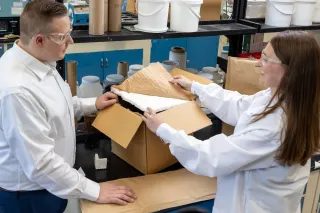“At first, I couldn’t even imagine that we could turn orange peels into plastic bottles. The prospect was naturally exciting from a chemist’s perspective, but it was great to realise that this was another way to look at the technology.”
What if you could drink orange juice from a bottle that was made from orange peels? VTT is working to make it a reality. Researcher Sari Rautiainen has been involved with the development of FDCA technology, which enables making plastic bottles from pectin – a substance found in plant sources such as citrus peels and sugar beets.
The process uses the by-products of agriculture and food production, more specifically waste that contains pectin. At the moment, nearly all plastic is produced with fossil sources, namely oil, which is why we need new technologies and raw materials. There are in fact two options – either using chemistry to produce exactly the same product, or using bio-based materials that have a different chemical composition but the same properties. FDCA technology represents the latter, replacing PET plastic entirely with a bio-based material.
Better than plastic
Research is rarely straightforward, and this technology makes no exception.
“Chemistry is kind of like playing with extremely small Lego bricks to create something new”, says Rautiainen.
Rautiainen is inspired to keep going and create new things by the concrete aspect of it all. For this, VTT has been exactly the right place – a step away from academia, closer to industry and commercial applications. It is wonderful to see the fruits of your labour in practice, and all this makes work meaningful for Rautiainen. The same applies to this specific technology, seeing as the end result is so tangible.
It’s been great to come in from left field with a solution that has turned out to be so successful.”
In fact, FDCA gives bottles even better properties than PET plastic. PEF plastic bottles made with FDCA technology will have better insulation when it comes to liquid and gas, resulting in better protective properties. Even though the invention is not yet commercially available, production has already been scaled up from grams to kilos. In research, this is a significant change and a big step forward.
Bio-based and biodegradable are not the same
In the fight against climate change, reducing carbon dioxide emissions is essential. Another important aspect is a transition of materials and chemicals, allowing us to start using bio-based and renewable raw materials. One discussion running alongside bio-based production is biodegradability, a two-edged sword:
“Would you really want a biodegradable Coke bottle?” Rautiainen asks laughing and adds:
“In some cases, biodegradability is a plus, when you’re talking about products with a limited lifespan. At the same time, we need to boost recycling for both bio-based and fossil-based plastics, because an effective recycling system is a cornerstone of circular economy.”
So we also need sustainably produced and recyclable materials. These are all issues that research aims to solve. Rautiainen feels that it is important to be involved in bringing concrete solutions directly to companies.
And where are we currently at with the lemon peel bottles? The next challenge is making the process more effective and environmentally friendly while also looking for new partners to join the effort. Also, Rautiainen already has a vision for another useful raw material – muconic acid, which could be used for developing products like bio-based tights.





